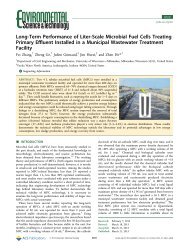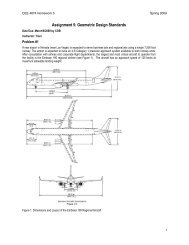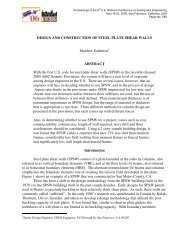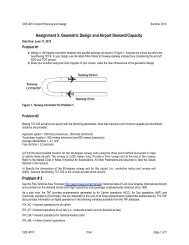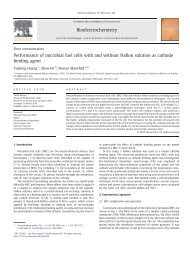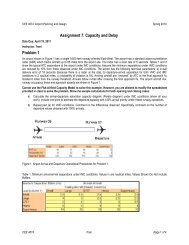Hydrogen production in microbial electrolysis cells: Choice of catholyte
Hydrogen production in microbial electrolysis cells: Choice of catholyte
Hydrogen production in microbial electrolysis cells: Choice of catholyte
You also want an ePaper? Increase the reach of your titles
YUMPU automatically turns print PDFs into web optimized ePapers that Google loves.
<strong>in</strong>ternational journal <strong>of</strong> hydrogen energy 38 (2013) 9619e9624 9621Table 1 e Coulombic efficiencies and hydrogen <strong>production</strong> <strong>in</strong> the MEC with different <strong>catholyte</strong>s.Catholytes Time period (day) Coulombicrecovery: CR (%)Cathodic H 2recovery: R cat (%)Overall H 2recovery: R H2 (%)H 2 <strong>production</strong>rate: Q H2 (m 3 H 2 /m 3 /d)100 mM PBS 1.44 0.10 34.6 1.0 89.2 9.2 30.8 2.3 0.237 0.03150 mM PBS 1.06 0.06 18.7 2.0 89.2 6.6 16.7 1.4 0.165 0.00525 mM PBS 1.11 0.07 13.2 0.4 80.1 3.7 10.6 0.8 0.100 0.00710 mM PBS 1.29 0.07 8.0 0.5 69.9 8.1 5.6 0.3 0.048 0.007134 mM NaCl 2.01 0.12 26.5 1.5 120.4 4.4 31.8 1.2 0.171 0.012100 mM NaCl 1.55 0.06 19.8 1.4 91.2 3.4 18.0 0.8 0.116 0.004200 mM NaCl 1.30 0.07 19.7 3.5 93.7 5.0 18.4 2.8 0.143 0.009DI water 5.10 1.47 42.8 6.8 67.9 12.6 28.5 1.4 0.065 0.021Tap water 3.14 0.61 10.9 2.6 93.8 22.1 9.8 0.1 0.034 0.007Acidified water (pH 4) a 2.81 0.18 11.0 2.1 156.3 17.3 17.0 1.3 0.065 0.002Acidified water (pH 2) a 1.19 0.05 21.5 0.8 84.7 1.8 18.2 0.5 0.171 0.004Acidified water (pH 2) b 1.37 0.07 18.5 2.0 65.5 8.4 12.0 0.8 0.089 0.002a Adjusted by sulfuric acid.b Adjusted by hydrochloric acid.to an external resistor (10 U), then to the cathode electrode,and the positive pole to the anode electrode.The MEC was operated <strong>in</strong> a fed-batch mode at 20 C. Theanode chamber was <strong>in</strong>oculated us<strong>in</strong>g anaerobic sludge fromSouth Shore Water Reclamation Facility (Milwaukee, WI,USA). The anode feed<strong>in</strong>g solution was prepared <strong>in</strong> tap waterconsist<strong>in</strong>g <strong>of</strong> 1.0 g/L sodium acetate, 0.3 g/L NH 4 Cl, 1.0 g/LNaCl, 0.03 g/L MgSO 4 , 0.04 g/L CaCl 2 , 0.2 g/L NaHCO 3 , 5.3 g/LKH 2 PO 4 , 10.7 g/L K 2 HPO 4 and 1 mL/L trace elements [8]. Fourgroups <strong>of</strong> <strong>catholyte</strong>s were exam<strong>in</strong>ed <strong>in</strong> the MEC: PBS, NaClsolution, water, and acidified water. The PBS was tested <strong>in</strong>four concentrations, 10, 25, 50, and 100 mM. The NaCl solutionwas prepared by dissolv<strong>in</strong>g NaCl <strong>in</strong> tap water to 100, 134, and200 mM. Two waters, tap water and deionized (DI) water, werestudied. The acidified water was prepared <strong>in</strong> two pHs, 2 and 4,us<strong>in</strong>g hydrochloric acid (HCl) or sulfuric acid (H 2 SO 4 ). The<strong>catholyte</strong> was completely replaced when the voltage droppedbelow 2 mV. The new <strong>catholyte</strong> was flushed with nitrogen gasfor 15 m<strong>in</strong> to remove any oxygen before start<strong>in</strong>g MEC operation.The anolyte was replaced by 80% with a fresh anodefeed<strong>in</strong>g solution at the same time when the <strong>catholyte</strong> wasreplaced. Dur<strong>in</strong>g the extended-<strong>catholyte</strong> study, the anolytewas replaced when the voltage decreased below 2 mV, but the<strong>catholyte</strong> was not replenished.2.2. Measurement and analysisThe voltage was monitored and recorded every 5 m<strong>in</strong> by adigital multimeter (Keithley Instruments Co., Ltd., USA). Theconcentration <strong>of</strong> chemical oxygen demand (COD) wasanalyzed by a DR/890 colorimeter (HACH Co., Ltd., USA). ThepH was measured us<strong>in</strong>g a bench-top pH meter (Oakton InstrumentsCo., Ltd., USA) and the electrical conductivity wasmeasured by a bench-top conductivity meter (Mettler-ToledoCo., Ltd., USA). The <strong>production</strong> <strong>of</strong> hydrogen gas was measuredby water replacement and analyzed by us<strong>in</strong>g a gasTable 2 e COD removal <strong>in</strong> anolyte and characteristics <strong>of</strong> effluent <strong>catholyte</strong> with different <strong>catholyte</strong>s.Catholytes COD removal (%) COD removal rate Effluent pHConductivity (ms/cm)(g COD/m 3 /d)InitialEffluent100 mM PBS 94.6 0.3 0.54 0.04 9.2 0.2 13.97 0.01 12.15 0.2350 mM PBS 97.0 0.4 0.69 0.07 8.9 0.2 8.52 0.80 9.67 0.3525 mM PBS 97.5 0.4 0.66 0.06 10.8 0.2 4.06 0.04 5.40 0.3010 mM PBS 97.2 0.4 0.59 0.05 11.3 0.2 1.44 0.48 2.63 0.57134 mM NaCl 96.7 0.7 0.37 0.03 12.2 0.1 13.88 0.24 21.07 0.65100 mM NaCl 95.9 1.8 0.44 0.02 12.0 0.1 7.68 0.66 15.28 0.92200 mM NaCl 96.7 0.2 0.54 0.05 11.9 0.1 20.00 0.20 25.05 0.30DI water 94.6 2.3 0.15 0.04 12.6 0.1 0.01 0.00 1.56 0.08Tap water 86.6 0.8 0.24 0.05 11.6 0.4 0.30 0.02 2.53 0.50Acidified water (pH 4) a 97.4 0.1 0.27 0.01 11.9 0.4 0.05 0.01 2.94 0.38Acidified water (pH 2) a 98.2 0.3 0.66 0.02 9.0 0.7 7.37 0.05 3.61 0.25Acidified water (pH 2) b 96.8 0.2 0.51 0.03 11.0 0.4 5.46 0.02 3.27 0.49a Adjusted by sulfuric acid.b Adjusted by hydrochloric acid.



